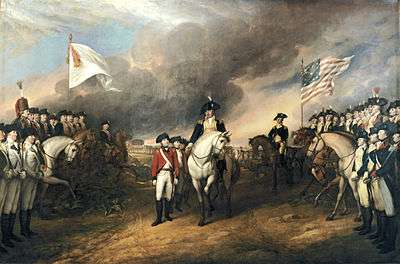Royal Deux-Ponts Regiment
| Régiment Royal-Deux-Ponts | |
|---|---|
 | |
| Active | 1757-1791 |
| Country |
Palatine Zweibrücken |
| Allegiance |
|
| Branch | Infantry |
| Type | Infantry of the line |
| Size | 2-4 Battalions |
| Engagements |
Seven Years' War American Revolution |
 |
| Armed Forces |
| United States |
|---|
| Great Britain |
| France |
| Related topics |
The Régiment Royal Deux-Ponts, (Zweibrücken/Two Bridges) was a French foreign regiment of Foot, created under the Ancien Régime in 1757.
Creation
The regiment was raised on 1 April 1757 by the duc de Deux-Ponts (Herzogtum Zweibrücken) in his estates as well as in Alsatian bailiwicks. This family owned the Petite-Pierre county, the bailiwicks of Bischwiller, Guttemberg, Seltz and Hagenbach. Outside France, it also owned the bailiwicks of Neucastel, Barbelroth, Cleeburg and Weylenbourg in Alsace.
Organization
The regiment initially counted 2 battalions but was soon increased to 3 battalions. In February 1758, the regiment was increased to 4 battalions. On January 18, 1760, when the German Infantry was reorganised, the regiment was reduced to its original strength.
Seven Years' War
Somewhere between August 23 and September 6, 1757, the regiment joined the Army of Saxony, led by Charles, Prince of Soubise, in the area of Erfurt and Eisenach. Soubise considered the regiment as of a particularly bad quality. On 27 September it was combined with Royal Roussillon Infanterie in the first line of the left wing of the Franco-Imperial Army. On 5 November the regiment was at the Battle of Rossbach, brigaded with the Royal Roussillon Infanterie in the first line of the centre. At the end of the year, it took winter quarters on the Kinzig River in Hessen.
At the end of January 1758, the regiment was assigned to the army that Louis XV planned to send to Bohemia for joint operations with the Austrian Army. However, when Ferdinand of Brunswick launched his surprise offensive in Western Germany, the regiment retreated towards Düsseldorf and Deutz with the bulk of Broglie's army. It passed the Rhine on 3–4 April. In the first days of June, Soubise's army assembled near Friedberg for an offensive in Hesse. The regiment was part of a detachment under the command of Broglie who followed up Ysenburg during his retreat. On 23 July 1758, the regiment took part in the Battle of Sandershausen where one of its battalions was placed in the first line of the centre to support Royal Bavière Infanterie, while another battalion guarded the defiles at Sandershausen and the two remaining battalions guarded the town of Kassel. Three of its grenadier companies fought against the Hessian force occupying the Ellenbach woods on the French right wing.
On April 13, 1759, the regiment took part in the Battle of Bergen where it was part of the troops occupying the town of Bergen. In 1761, the regiment was at Frankfurt am Main. In 1762, the regiment served in Western Germany.
It was commanded by Baron de Clozen in 1758 and from February 20, 1761 to February 21, 1765 by Baron de Scheidt.
American Revolution
The "Royal Regiment of Two Bridges", commanded by the Comte Christian de Forbach, was part of the Expédition Particulière (French Expeditionary Force) that was sent to the United States to help it fight for its independence. The Regiment was commanded by Comte Christian de Forbach (son of Christian IV, Count Palatine of Zweibrücken). His deputy commander was his brother Philippe Guillaume (later renamed to Wilhelm) and was one of the four regiments that arrived at Newport with Rochambeau in 1780 and went on to participate in the Battle of Yorktown on the side of the Americans in 1781.
Many of the soldiers came from the region around the city of Zweibrücken (German for "Two Bridges", French: deux ponts), an independent duchy within the Holy Roman Empire whose territories are now parts of Germany or France.
Disbandment
In 1791 the regiment became the French 99e régiment d’infanterie de ligne. Its second battalion was transferred to the new 178e demi-brigade de bataille in 1794, and the first battalion to the new 177e demi-brigade de bataille in 1795. In the Republic its tradition was maintained by the 99e régiment d'infanterie from its creation in 1855 until its disbandment in 1997.
External links
- Uniform of a chasseur (Rifleman) of the Royal Deux-Ponts during the American Revolution.
 Colonel's Colors
Colonel's Colors Colors of the Royal Deux-Ponts.
Colors of the Royal Deux-Ponts.
References
- ↑ "Royal Deux-Ponts Infanterie – Project SYW". Kronoskaf.com. 2012-01-08. Retrieved 2013-11-09.